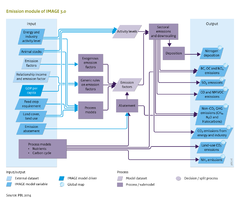Emissions/Description: Difference between revisions
Jump to navigation
Jump to search
No edit summary |
No edit summary |
||
| Line 54: | Line 54: | ||
Land-use related emissions of NH3, N2O and NO are calculated with a grid-specific model, N2O from soils under natural vegetation is calculated with the model of [[Bouwman et al., 1993]]. This model is a regression model based on temperature, a proxy for soil carbon input, soil water and oxygen status and a proxy for net primary production. Ammonia emission from natural vegetation is based on net primary production, C:Nratio and an emission factor, and the model accounts for in-canopy retention of the emitted NH3 ([[Bouwman et al., 1997]]). | Land-use related emissions of NH3, N2O and NO are calculated with a grid-specific model, N2O from soils under natural vegetation is calculated with the model of [[Bouwman et al., 1993]]. This model is a regression model based on temperature, a proxy for soil carbon input, soil water and oxygen status and a proxy for net primary production. Ammonia emission from natural vegetation is based on net primary production, C:Nratio and an emission factor, and the model accounts for in-canopy retention of the emitted NH3 ([[Bouwman et al., 1997]]). | ||
For agricultural emissions of N2O, the most important determinant factors are N application rate, climate type, soil organic-C content, soil texture, drainage, soil pH, type of crop, and type of fertilizer; the most important controls on NO emission include the N application rate per fertilizer type and soil organic-C content and soil drainage. (for a detailed description, see [[Bouwman et al., 2002a]]. Agricultural emissions of NH3 from fertilized cropland and grassland uses the factors type of crop, fertilizer application rate by type and application mode, temperature, soil pH, and CEC ([[Bouwman et al., | For agricultural emissions of N2O, the most important determinant factors are N application rate, climate type, soil organic-C content, soil texture, drainage, soil pH, type of crop, and type of fertilizer; the most important controls on NO emission include the N application rate per fertilizer type and soil organic-C content and soil drainage. (for a detailed description, see [[Bouwman et al., 2002a]]. Agricultural emissions of NH3 from fertilized cropland and grassland uses the factors type of crop, fertilizer application rate by type and application mode, temperature, soil pH, and CEC ([[Bouwman et al., 2002a]]). | ||
It should be noted that for comparison with other models, IMAGE also inludes the N2O methodology for sources as proposed by IPCC ([[IPCC, 2006]]). This methodology represents only the anthropogenic increase. This emission cannot be compared with the above model approach, which calculates the total emission. | It should be noted that for comparison with other models, IMAGE also inludes the N2O methodology for sources as proposed by IPCC ([[IPCC, 2006]]). This methodology represents only the anthropogenic increase. This emission cannot be compared with the above model approach, which calculates the total emission. | ||
Revision as of 11:40, 15 January 2014
Parts of Emissions/Description
| Component is implemented in: |
Components:and
|
| Projects/Applications |
| Models/Databases |
| Key publications |
| References |
|
